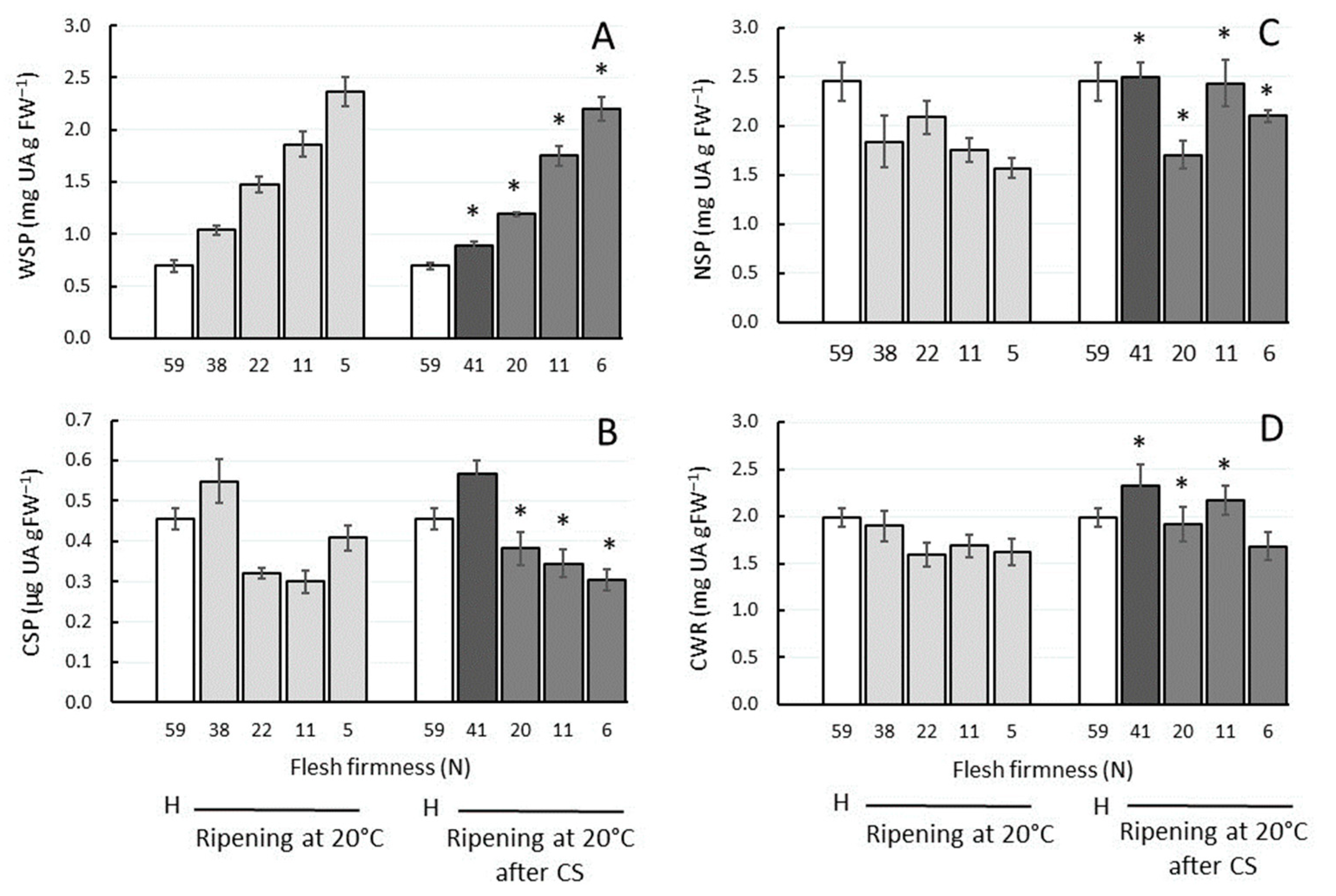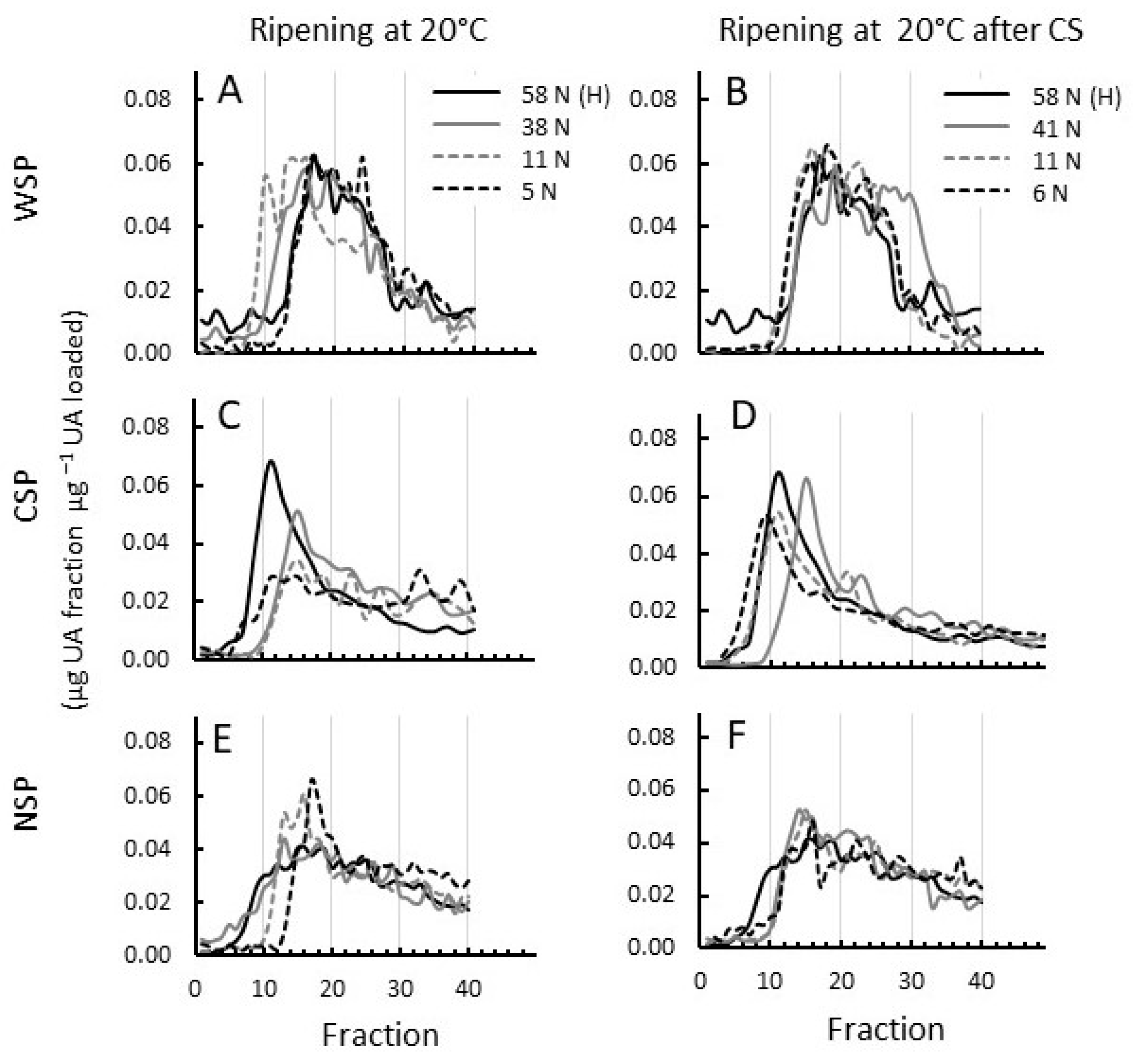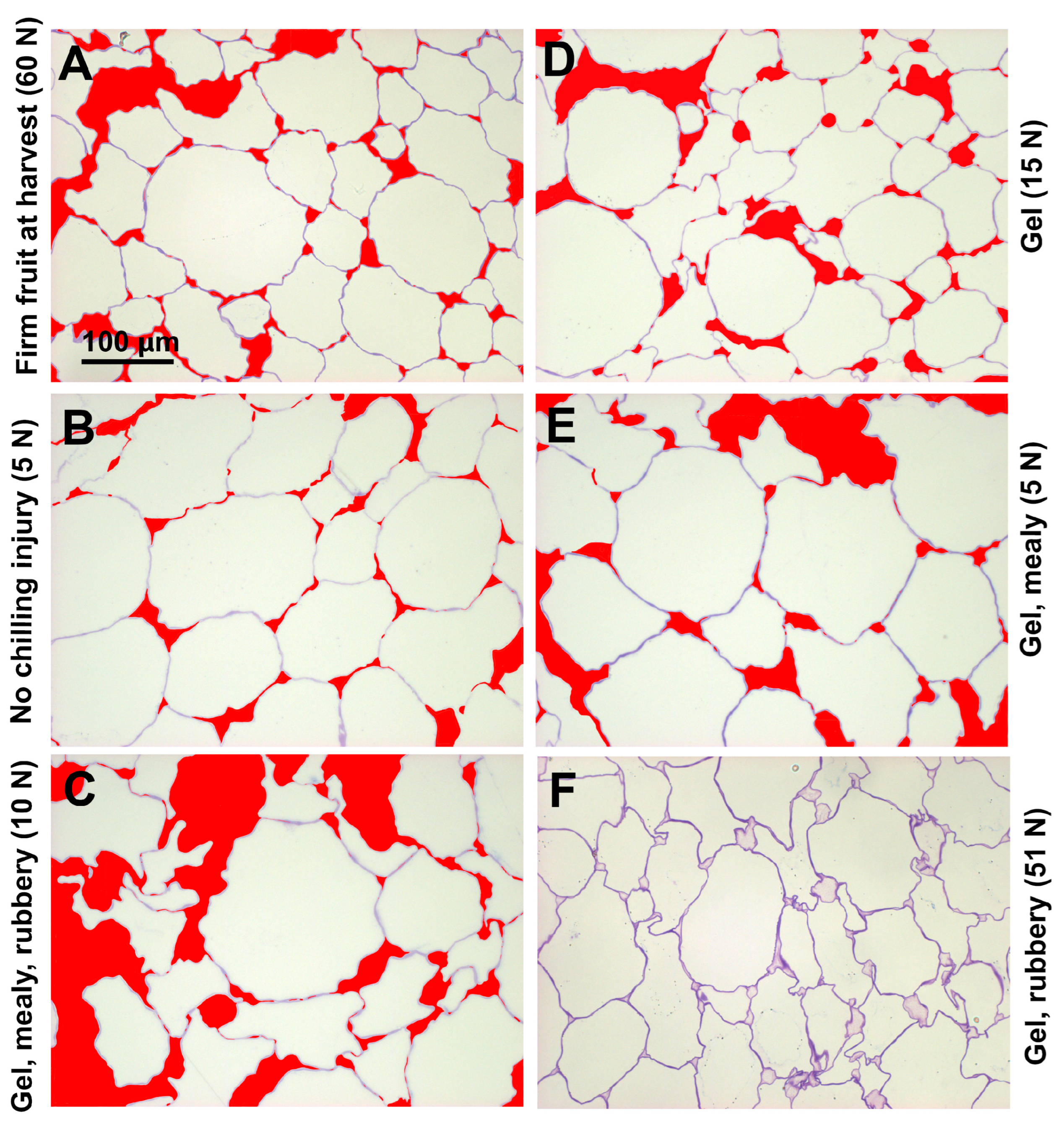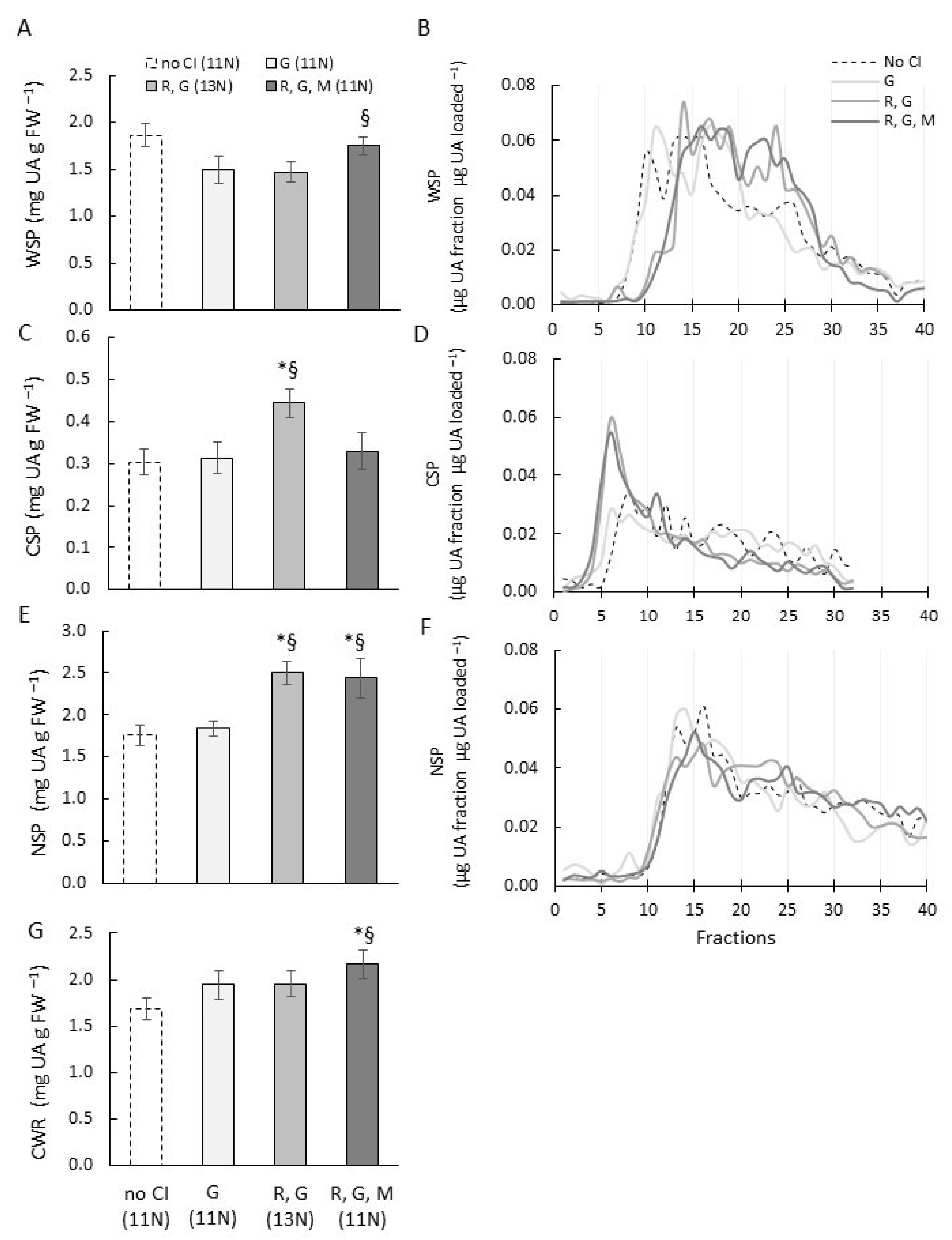Dissecting the Role of Cell Wall Changes in Chilling Injury-Induced Gel Formation, Rubberiness, and Mealiness in Apricots
Abstract
:1. Introduction
2. Materials and Methods
2.1. Plant Material and Experimental Design
2.2. Fruit Phenotyping and Sensory Assessments
2.3. Cell Wall Isolation and Extraction
2.4. Size Exclusion Chromatography
2.5. Light Microscopy and Immunolabelling
2.6. Statistical Analysis
3. Results
3.1. Pectin Metabolism Is Different between Apricots with and without Chilling Injury (CI) Symptoms of Mealiness, Gel Formation, and Rubberiness
3.2. Changes in Extent of Cell Separation and Cell Shape in Fruit Ripened at 20 °C and after Cold Storage
3.3. Intercellular Spaces and Cell Lumen of Eating-Soft Chilling-Injured Apricots Were Filled with Pectin, Similar to Fruit at Harvest
3.4. Fruit with Combinations of CI Symptoms Had Different Pectin Localisation, Content, and Molecular Weight Distribution
4. Discussion
Supplementary Materials
Author Contributions
Funding
Data Availability Statement
Acknowledgments
Conflicts of Interest
References
- Stanley, J.; Prakash, R.; Marshall, R.; Schröder, R. Effect of harvest maturity and cold storage on correlations between fruit properties during ripening of apricot (Prunus armeniaca). Postharvest Biol. Technol. 2013, 82, 39–50. [Google Scholar] [CrossRef]
- Manolopoulou, H.; Mallidis, C. Storage and processing of apricots. Acta Hortic. 1999, 488, 567–576. [Google Scholar] [CrossRef]
- Stanley, J.; Marshall, R.; Ogwaro, J.; Feng, R.; Wohlers, M.; Woolf, A.B. Postharvest storage temperatures impact significantly on apricot fruit quality. Acta Hortic. 2010, 880, 525–532. [Google Scholar] [CrossRef]
- Fan, X.; Jiang, W.; Gong, H.; Yang, Y.; Zhang, A.; Liu, H.; Caob, J.; Guod, F.; Cuie, K. Cell wall polysaccharides degradation and ultrastructure modification of apricot during storage at a near freezing temperature. Food Chem. 2019, 300, 125194. [Google Scholar] [CrossRef] [PubMed]
- Li, Y.; Zhao, Y.; Zhang, Z.; He, H.; Shi, L.; Zhu, X.; Cui, K. Near-freezing temperature storage improves shelf-life and suppresses chilling injury in postharvest apricot fruit (Prunus armeniaca L.) by regulating cell wall metabolism. Food Chem. 2022, 387, 132921. [Google Scholar] [CrossRef]
- Brummell, D.A.; Dal Cin, V.; Crisosto, C.H.; Labavitch, J.M. Cell wall metabolism during maturation, ripening and senescence of peach fruit. J. Exp. Bot. 2004, 55, 2029–2039. [Google Scholar] [CrossRef]
- Muramatsu, N.; Tanaka, K.; Asakura, T.; Haji, T. Changes in cell wall polysaccharides and physical properties of peach (Prunus persica Batsch) fruit during ripening. J. Jpn. Soc. Hortic. Sci. 2004, 73, 534–540. [Google Scholar] [CrossRef]
- Fruk, G.; Cmelika, Z.; Jemrica, T.; Hribarb, J.; Vidrihb, R. Pectin role in woolliness development in peaches and nectarines: A review. Sci. Hortic. 2014, 180, 1–5. [Google Scholar] [CrossRef]
- Liu, H.; Chen, F.S.; Yang, H.S.; Yao, Y.Z.; Gong, X.Z.; Xin, Y.; Ding, C.H. Effect of calcium treatment on nanostructure of chelate-soluble pectin and physicochemical and textural properties of apricot fruits. Food Res. Int. 2009, 42, 1131–1140. [Google Scholar] [CrossRef]
- Tsuchida, Y.; Yakushiji, H.; Oe, T.; Negoro, K.; Gato, N.; Kotani, T.; Onishi, Y.; Kobata, T.; Tamura, M. Differences in cell-wall polysaccharide degradation during softening process in two cultivars of Japanese apricot fruits. J. Jpn. Soc. Hortic. Sci. 2014, 83, 81–89. [Google Scholar] [CrossRef]
- Stanley, J.; Feng, J.; Olsson, S. Crop load and harvest maturity effects on consumer preferences for apricots. J. Sci. Food Agric. 2014, 95, 752–763. [Google Scholar] [CrossRef] [PubMed]
- Stanley, J. Control of Pre-Harvest and Postharvest Factors to Improve Fruit Quality of Apricot. Ph.D. Thesis, School of Natural Sciences, Griffith University, Brisbane, Australia, 2015. [Google Scholar]
- Schröder, R.; Nicolas, P.; Vincent, S.J.F.; Fischer, M.; Reymond, S.; Redgwell, R.J. Purification and characterisation of a galactoglucomannan from kiwifruit (Actinidia deliciosa). Carbohydr. Res. 2001, 331, 291–306. [Google Scholar] [CrossRef] [PubMed]
- Blumenkrantz, N.; Asboe-Hansen, G. New method for quantitative determination of uronic acids. Anal. Biochem. 1973, 54, 484–489. [Google Scholar] [CrossRef] [PubMed]
- Lahaye, M.; Falourd, X.; Quemener, B.; Devaux, M.F.; Audergon, J.M. Histological and cell wall polysaccharide chemical variability among apricot varieties. LWT Food Sci. Technol. 2014, 58, 486–496. [Google Scholar] [CrossRef]
- Sutherland, P.; Hallett, I.; Jones, M. Probing cell wall structure and development by the use of antibodies: A personal perspective. N. Z. J. For. Sci. 2009, 39, 197–205. [Google Scholar]
- Harker, F.R.; Hallett, I.C. Physiological-changes associated with development of mealiness of apple fruit during cool storage. HortScience 1992, 27, 1291–1294. [Google Scholar] [CrossRef]
- Harker, F.R.; Sutherland, P.W. Physiological changes associated with fruit ripening and the development of mealy texture during storage of nectarines. Postharvest Biol. Technol. 1993, 2, 269–277. [Google Scholar] [CrossRef]
- Kovacs, E.; Meresz, P.; Kristof, Z.; Nemeth-Szerdahelyi, E. Ripening and microstructure of apricot (Prunus armeniaca L.). Acta Aliment. 2008, 37, 23–39. [Google Scholar] [CrossRef]
- Ju, Z.G.; Duan, J.S.; Ju, Z.Q. Leatheriness and mealiness of peaches in relation to fruit maturity and storage temperature. J. Hortic. Sci. 2000, 75, 86–91. [Google Scholar] [CrossRef]
- Luza, J.G.; Vangorsel, R.; Polito, V.S.; Kader, A.A. Chilling injury in peaches—A cytochemical and ultrastructural cell-wall study. J. Am. Soc. Hortic. Sci. 1992, 117, 114–118. [Google Scholar] [CrossRef]
- Brummell, D.A.; Dal Cin, V.; Lurie, S.; Crisosto, C.H.; Labavitch, J.M. Cell wall metabolism during the development of chilling injury in cold-stored peach fruit: Association of mealiness with arrested disassembly of cell wall pectins. J. Exp. Bot. 2004, 55, 2041–2052. [Google Scholar] [CrossRef] [PubMed]
- Harker, R.F.; Maindonald, J.H. Ripening of nectarine fruit. Plant Physiol. 1994, 106, 165–171. [Google Scholar] [CrossRef] [PubMed]
- Lurie, S.; Crisosto, C.H. Chilling injury in peach and nectarine. Postharvest Biol. Technol. 2005, 37, 195–208. [Google Scholar] [CrossRef]
- Hunter, D.A.; Napier, N.J.; Erridge, Z.A.; Saei, A.; Chen, R.K.Y.; McKenzie, M.J.; O’Donoghue, E.M.; Hunt, M.; Favre, L.; Lill, R.E.; et al. Transcriptome responses of ripe cherry tomato fruit exposed to chilling and rewarming identify reversible and irreversible gene expression changes. Front. Plant Sci. 2021, 12, 685416. [Google Scholar] [CrossRef]
- Manganaris, G.A.; Vicente, A.R.; Crisosto, C.H.; Labavitch, J.M. Cell wall modifications in chilling-injured plum fruit (Prunus salicina). Postharvest Biol. Technol. 2008, 48, 77–83. [Google Scholar] [CrossRef]
- Zhou, H.W.; Dong, L.; Ben-Arie, R.; Lurie, S. The role of ethylene in the prevention of chilling injury in nectarines. J. Plant Physiol. 2001, 158, 55–61. [Google Scholar] [CrossRef]
- Zhou, H.W.; Lurie, S.; Ben-Arie, R.; Dong, L.; Burd, S.; Weksler, A.; Lers, A. Intermittent warming of peaches reduces chilling injury by enhancing ethylene production and enzymes mediated by ethylene. J. Hortic. Sci. Biotechnol. 2001, 76, 620–628. [Google Scholar]
- Zhang, B.; Xi, W.; Wei, W.; Shen, J.; Ferguson, I.; Chen, K. Changes in aroma-related volatiles and gene expression during low temperature storage and subsequent shelf-life of peach fruit. Postharvest Biol. Technol. 2011, 60, 7–16. [Google Scholar] [CrossRef]
- Leguizamon, G.; Luchsinger, L.; Razeto, B. Water loss and ethylene as non-destructive symptoms of chilling injury in ‘Eureka’ lemons. Acta Hortic. 2001, 553, 297–298. [Google Scholar] [CrossRef]
- Feng, J.; Maguire, K.; MacKay, B.R. Factors affecting ethylene production of Hayward kiwifruit. Acta Hortic. 2003, 610, 203–209. [Google Scholar] [CrossRef]
- Khan, A.S.; Ahmed, M.J.; Singh, Z. Increased ethylene biosynthesis elevates incidence of chilling injury in cold-stored ‘Amber Jewel’ Japanese plum (Prunus salicina Lindl.) during fruit ripening. Int. J. Food Sci. Technol. 2011, 46, 642–650. [Google Scholar] [CrossRef]
- Fernández-Trujillo, J.P.; Cano, A.; Artés, F. Physiological changes in peaches related to chilling injury and ripening. Postharvest Biol. Technol. 1998, 13, 109–119. [Google Scholar] [CrossRef]
- Liu, B.; Zhao, H.; Fan, X.; Jiao, W.; Cao, J.; Jiang, W. Near freezing point temperature storage inhibits chilling injury and enhances the shelf life quality of apricots following long-time cold storage. J. Food Process. Preserv. 2019, 43, e13958. [Google Scholar] [CrossRef]
- Koushesh saba, M.; Arzani, K.; Barzegar, M. Postharvest polyamine application alleviates chilling injury and affects apricot storage ability. J. Agric. Food Chem. 2012, 60, 8947–8953. [Google Scholar] [CrossRef] [PubMed]
- Abdi, N.; McGlasson, W.B.; Holford, P.; Williams, M.; Mizrahi, Y. Responses of climacteric and suppressed-climacteric plums to treatment with propylene and 1-methylcyclopropene. Postharvest Biol. Technol. 1998, 14, 29–39. [Google Scholar] [CrossRef]
- Liu, H.; Chen, F.; Lai, S.; Tao, J.; Yang, H.; Jiao, Z. Effects of calcium treatment and low temperature storage on cell wall polysaccharide nanostructures and quality of postharvest apricot (Prunus armeniaca). Food Chem. 2017, 225, 87–97. [Google Scholar] [CrossRef]





| Chilling Injury Scores | |||||||
|---|---|---|---|---|---|---|---|
| Storage Temperature (°C) | Weeks in Storage | Days Shelf-Life at 20 °C | Flesh Firmness (N) | Rubbery | Gel | Mealiness | Juiciness |
| - | Harvest | 0 | 59 ± 2.2 | 0.0 ± 0.0 | 0.0 ± 0.0 | 0.0 ± 0.0 | 1.8 ± 0.2 |
| - | 0 | 2 | 38 ± 1.3 | 0.0 ± 0.0 | 0.0 ± 0.0 | 0.0 ± 0.0 | 2.7 ± 0.3 |
| - | 0 | 4 | 22 ± 1.0 | 0.0 ± 0.0 | 0.0 ± 0.0 | 0.0 ± 0.0 | 2.1 ± 0.1 |
| - | 0 | 8 | 11 ± 0.6 | 0.5 ± 0.0 | 0.0 ± 0.0 | 0.0 ± 0.0 | 1.4 ± 0.1 |
| - | 0 | 10 | 5 ± 0.7 | 0.7 ± 0.3 | 0.0 ± 0.0 | 0.0 ± 0.0 | 1.3 ± 0.2 |
| 0 | 5 | 0 | 41 ± 2.1 | 1.5 ± 0.0 | 0.3 ± 0.0 | 0.0 ± 0.0 | 1.5 ± 0.2 |
| 0 | 5 | 2 | 20 ± 2.0 | 2.0 ± 0.0 | 2.9 ± 0.1 | 0.2 ± 0.1 | 1.3 ± 0.2 |
| 0 | 5 | 5 | 11 ± 0.7 | 2.8 ± 0.3 | 3.0 ± 0.0 | 1.2 ± 0.3 | 0.8 ± 0.3 |
| 0 | 5 | 8 | 6 ± 1.1 | 0.3 ± 0.0 | 3.0 ± 0.0 | 1.6 ± 0.3 | 0.6 ± 0.1 |
Disclaimer/Publisher’s Note: The statements, opinions and data contained in all publications are solely those of the individual author(s) and contributor(s) and not of MDPI and/or the editor(s). MDPI and/or the editor(s) disclaim responsibility for any injury to people or property resulting from any ideas, methods, instructions or products referred to in the content. |
© 2023 by the authors. Licensee MDPI, Basel, Switzerland. This article is an open access article distributed under the terms and conditions of the Creative Commons Attribution (CC BY) license (https://creativecommons.org/licenses/by/4.0/).
Share and Cite
Stanley, C.J.; Scofield, C.; Hallett, I.C.; Schröder, R. Dissecting the Role of Cell Wall Changes in Chilling Injury-Induced Gel Formation, Rubberiness, and Mealiness in Apricots. Horticulturae 2023, 9, 1115. https://doi.org/10.3390/horticulturae9101115
Stanley CJ, Scofield C, Hallett IC, Schröder R. Dissecting the Role of Cell Wall Changes in Chilling Injury-Induced Gel Formation, Rubberiness, and Mealiness in Apricots. Horticulturae. 2023; 9(10):1115. https://doi.org/10.3390/horticulturae9101115
Chicago/Turabian StyleStanley, C. Jill, Claire Scofield, Ian C. Hallett, and Roswitha Schröder. 2023. "Dissecting the Role of Cell Wall Changes in Chilling Injury-Induced Gel Formation, Rubberiness, and Mealiness in Apricots" Horticulturae 9, no. 10: 1115. https://doi.org/10.3390/horticulturae9101115
APA StyleStanley, C. J., Scofield, C., Hallett, I. C., & Schröder, R. (2023). Dissecting the Role of Cell Wall Changes in Chilling Injury-Induced Gel Formation, Rubberiness, and Mealiness in Apricots. Horticulturae, 9(10), 1115. https://doi.org/10.3390/horticulturae9101115





